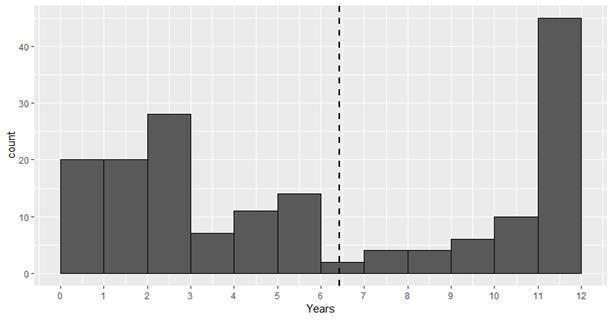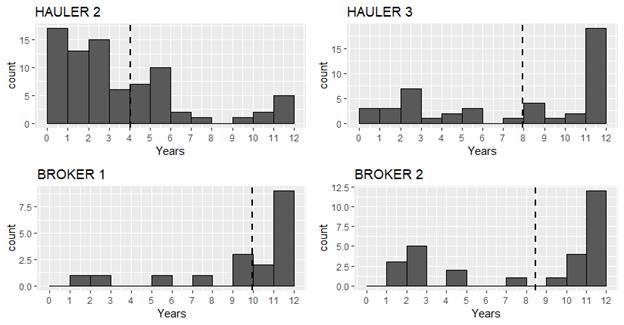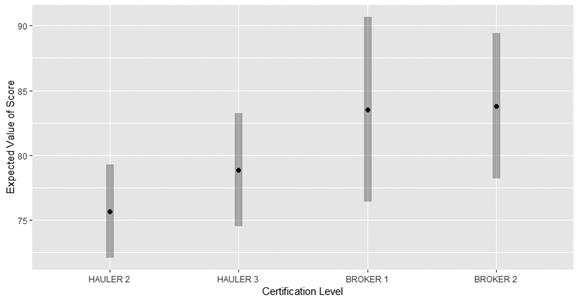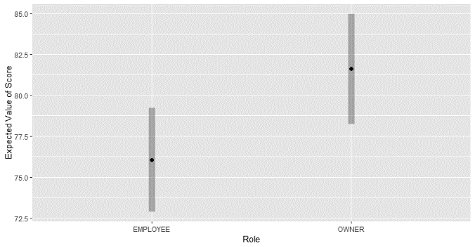 |
April 2020
|
April 2020 // Volume 58 // Number 2 // Research In Brief // v58-2rb4
Description and Educational Impact of Pennsylvania's Manure Hauler and Broker Certification Program
Abstract
We describe Pennsylvania's Commercial Manure Hauler and Broker Certification Program and discuss results of an industry survey. Survey knowledge questions were centered on state-mandated program competencies designed to minimize environmental losses of manure nutrients. Survey results demonstrated that participation in state-directed, Extension-led educational programming resulted in greater knowledge for those required to complete more rigorous certification education and for those exposed to more continuing education. Educational impact is expected to be far-reaching as survey respondents worked on an average of 38.5 farms annually. Extension's role is critical in this certification program that endeavors to improve water quality.
Introduction
A foundational component of balancing agricultural production and environmental stewardship is proper implementation of nutrient and manure management plans. Every farm operator who generates or uses manure must develop a plan that meets state requirements. Agronomic and environmental goals are served when manure applicators implement sound operational practices, calibrate application equipment, and understand and adhere to environmental requirements. Farms with high animal concentrations may have a nutrient supply in excess of crop needs, increasing the risk of nonpoint nutrient loss (Sharpley et al., 1994). In Pennsylvania, these issues are most concentrated within the Chesapeake Bay watershed and often act as the driver for nutrient and manure management regulations across the state (Beegle, 2013). According to the 2010 Chesapeake Bay total maximum daily load report, Pennsylvania contributed 55% of the total nitrogen load and 24% of the total phosphorus load associated with agriculture across all states in the watershed (U.S. Environmental Protection Agency, 2010). In 2006, the Pennsylvania Department of Agriculture began an initiative to support state manure nutrient goals by requiring that all individuals who transport, land-apply, or broker manure in a commercial manner attain certification.
Certification programs based on education are viewed favorably as tools for contributing to the achievement of water quality improvement goals. Educational efforts that provide individual or group-based education compared to mass media sources are preferred by professionals in the nutrient management industry (Cortus et al., 2018). Continuing education of individuals certified within nutrient management programs facilitates knowledge of manure nutrient utilization above baseline program education (Wortmann, Koelsch, Shapiro, Deloughery, & Tarkalson, 2005), leading to increased environmental awareness that positively influences adoption of best management practices (Baumgart-Getz, Prokopy, & Floress, 2012). Agricultural producers recognize that education-based programs are important for voluntarily adopting practices and avoiding more arduous regulations, but influence of such programs on nutrient management and water quality is difficult to track or assess (Reimer, Denny, & Stuart, 2018).
Recently, for example, an advisory committee composed of industry and agency experts charged with improvement of agricultural water quality impacts in the Western Lake Erie Basin recognized the value of education and certification through adoption of the 4R Nutrient Stewardship Certification Program as a tool for reaching goals (Vollmer-Sanders, Allman, Busdeke, Moody, & Stanley, 2016). Program foci were directed toward nutrient service providers, with the important acknowledgment that these professionals interact with and influence nutrient management across thousands of acres and hundreds of farms (Vollmer-Sanders et al., 2016). Certification of commercial manure handlers has a similar rippling impact as the industry's professionals work with manure nutrients across many acres and farms. Pennsylvania's certification program for commercial manure haulers and brokers focuses on education of individuals, with Penn State Extension leading educational material development and dissemination. During education events in the program's 12th year, we used a survey to collect data, with our hypothesis being that both initial and continuing education are positively related to knowledge level of certified manure handlers.
Purpose
The purpose of this article is to (a) describe the Pennsylvania Act 49 Commercial Manure Hauler and Broker Certification program, (b) provide descriptive statistics of the program from a 2018 industry survey, and (c) demonstrate program impact on knowledge levels of certified individuals.
Certification Program and Survey Overview
Program Description
The Pennsylvania Commercial Manure Hauler and Broker Certification Act ("2004 Act 49," 2004), or Pa Act 49 of 2004, established baseline guidance for certification and education requirements for the state's professional manure handlers. Certification began in 2006, and final rule notice was published in January 2007 ("Rules and Regulations," 2007). To date, the unique statewide program has not been described in scientific literature. The Pennsylvania Department of Agriculture in collaboration with the State Conservation Commission maintains program oversight and administration, and Pennsylvania State University Extension leads educational efforts.
Pennsylvania law dictates that certification for commercial manure handlers occur on an individual level (not a business level). Due to the structure of the workforce within the professional manure handling industry, five certification categories were incorporated into regulations, according to the general philosophy that more responsibility requires more education and demonstration of proficiency, as summarized in Table 1. Required education and certification competencies outlined in the law include knowledge of pertinent laws and regulations, nutrient and manure management protocols, soil fertility and management principles, interpretation and implementation of nutrient and manure management plans, best management practices of manure application, manure application setback requirements, record-keeping obligations, biosecurity, odor principles, fly management, safety awareness, emergency action planning, manure equipment calibration, and manure stacking guidance. After certification, most individuals are required to complete continuing education credits (CECs) as outlined in Table 1. One CEC is equivalent to 1 hr of education and must be approved by the Pennsylvania State Conservation Commission. Extension typically develops CECs with the goal of reviewing and expanding competency via both classroom and field day forums.
| Certification level | Brief description | Education and certification requirements | CEC requirements |
|---|---|---|---|
| Manure Hauler 1
("Trucker") |
Transport but not land-apply manure.
Can unload manure at temporary field stacking locations. Work as employee or contract agent of a Manure Hauler 3, Manure Broker 1, or Manure Broker 2. |
Complete verification form to acknowledge understanding of basic environmental risks and safety hazards associated with this level. | No CEC requirements, but must complete checklist annually |
| Manure Hauler 2
("Employee") |
Transport and land-apply manure.
Must be employed and supervised by a Manure Hauler 3, Manure Broker 1, or Manure Broker 2. |
Complete verification form confirming study of 46-page Manure Hauler 2 Workbook. The form is signed by a supervisor.
Satisfactorily complete Hauler Level 2 Exam at a county office. |
6 CECs in 3-year period |
| Manure Hauler 3
("Owner or Manager") |
Transport and land-apply manure.
Can supervise those certified at Hauler Level 2. |
Attend state-level Act 49 Orientation certification class.
Satisfactorily complete Hauler 3/Broker 1 exam. |
9 CECs in 3-year period |
| Manure Broker 1 | Transport and land-apply manure.
Can assume ownership of manure and determine end use of manure. Cannot develop nutrient balance sheets that provide manure application guidance to farms that import manure. Can supervise those certified at Hauler Level 2. |
Attend state-level Act 49 Orientation certification class.
Satisfactorily complete Hauler 3/Broker 1 exam. |
9 CECs in 3-year period |
| Manure Broker 2 | Transport and land-apply manure.
Can assume ownership of manure and determine end use of manure. Can develop nutrient balance sheets. Can supervise those certified at Hauler Level 2. May take additional course to write phosphorus index (Beegle et al., 2007) plans. |
Attend state-level Act 49 Orientation certification class.
Satisfactorily complete Hauler 3/Broker 1 exam. Attend state-level nutrient balance sheet development class. Satisfactorily complete Broker 2 exam. Optional completion of phosphorus index (Beegle et al., 2007) training. |
12 CECs in 3-year period, 3 or more of which must be specific to nutrient balance sheets |
Survey Description
We developed a 29-question survey with guidance and approval from the Penn State Survey Research Center. We used 11 questions to collect anonymous descriptive information about the individual survey completer's certification level and role in the program. This information included certification level, role as employee or owner, role as supervised or supervisor, number of years in certification program, type of manure worked with, and number of farms worked with annually. Eighteen questions (Figure 1) were used to assess participant knowledge on program competency topics that included manure nutrient management and cycling, manure application setbacks and requirements, emergency spill response, soil compaction, farm biosecurity, and fly control. This survey structure allowed us to compare the amount of program education the individual received, both in terms of certification level educational material and number of years attending continuing education, with score on knowledge questions. This approach also allowed program coordinators to evaluate effectiveness of initial training and testing material. We distributed the survey at 11 CEC meeting locations across the state between January 23 and March 1, 2018. All individuals completed identical surveys.
| 1 | This level of manure hauler must be supervised when they transport or land-apply manure. A. Level 1 Commercial Manure Hauler B. Level 2 Commercial Manure Hauler C. Level 3 Commercial Manure Hauler |
10 | Please select the scenario below that indicates winter application rules must be followed? A. The date is December 14 B. There is snow on the ground on April 1st C. Corn silage was removed and no cover crop was planted D. It is early spring and grass hay has not yet begun to grow |
| 2 | Small farms do not need a manure or nutrient management plan. A. True B. False |
11 | During a manure spill, which of the following should be done first? A. Contain running spill B. Notify authorities C. Stop the flow at the source D. Look for spill guidelines in an Emergency Action Plan (EAP) |
| 3 | Which form of nitrogen volatilizes? A. Ammonia B. Organic N C. Nitrate D. Nitrous Oxide |
12 | When can freeboard be ignored? A. Spring because manure will soon be removed B. Winter because application cannot occur close to water C. Fall because manure will not be applied until spring growing season D. Freeboard should never be ignored or exceeded |
| 4 | What is the process by which nitrogen moves through the soil and into tile lines? A. Immobilization B. Denitrification C. Volatilization D. Leaching |
13 | Which 'manure gas' is considered the gas most dangerous to human health? A. Ammonia B. Hydrogen Sulfide C. Carbon Dioxide D. Methane |
| 5 | When a nutrient management plan is balanced on nitrogen what is usually true of phosphorus? A. Phosphorus will be below crop nutrient needs B. Phosphorus will also be in balance with crop need C. Phosphorus will be above crop nutrient needs |
14 | Which odor source leads to the most odor complaints? A. Building exhaust fans B. Liquid manure storages C. Manure application D. Solid manure storages |
| 6 | Which pathway is responsible for the highest loss of manure phosphorus? A. Erosion and runoff B. Volatilization C. Leaching D. Immobilization |
15 | Which scenario would you expect to lead to greatest soil compaction? A. Frozen soil B. Heavy axel weight C. High tire pressure D. Four wheel drive |
| 7 | What is the manure application setback from an active water well? A. 35 feet B. 50 feet C. 100 feet D. 150 feet |
16 | Which of the following represents the highest biosecurity risk? A. Visiting only one farm in a day B. Visiting multiple farms in a day C. Cleaning and disinfecting between farms D. Moving from younger to older animals |
| 8 | What condition must exist for manure application as close as 35 feet from a stream? A. No-till practices B. Slope of 15% or less C. Permanent vegetative buffer D. Cannot be winter |
17 | What is the best recommendation when fly larva (maggots) are observed in poultry litter? A. Apply litter before adult flies emerge B. Apply litter far away from houses C. Treat litter with pesticide D. Stack litter to kill larva with composting heat |
| 9 | How much ground cover is required for winter application? A. 10% B. 25% C. 30% D. 50% |
18 | A 10-acre field needs 6,000 gallons of swine manure per acre. You have a 5,000-gallon tank. How many loads of manure should you apply to the field? A. 10 loads B. 12 loads C. 15 loads D. 18 loads |
Statistical Analysis
Some surveys were removed from consideration when the individual listed himself or herself in the Manure Hauler Level 1 category due to low CEC participation where the survey was distributed. Also removed were those with missing values for questions of certification level, role as employee or owner, role as supervised or supervisor, number of years in certification program, type of manure worked with, and number of farms worked with annually. Additionally, any survey with five or more missing values in the knowledge questions was removed from analysis. These actions resulted in 171 acceptable surveys. Since a volunteer program was in place prior to 2006, some respondents listed themselves as having completed certification as early as the year 2000. For analysis, 12 individuals who responded that they were certified prior to 2006 were categorized as having had 12 years of certification experience to align with the inaugural certification year. We conducted a statistical analysis using R statistical software to explore the relationship between the knowledge questions score of the respondents and the factors of certification level, role as employee or owner, role as supervised or supervisor, number of years in certification program, type of manure worked with, and number of farms worked with annually.
Results and Discussion
On the last date the survey was distributed (March 1, 2018), the certified industry consisted of 808 individuals, including 231 Hauler 1s, 303 Hauler 2s, 134 Hauler 3s, 74 Broker 1s, and 66 Broker 2s. Only 2.6% of total industry Hauler Level 1s completed the survey, which was reasonable considering that individuals at that certification level are not required to attend CEC sessions, where the survey was distributed. The percentage of individuals completing the survey was much higher in all other categories (Table 2). The group of participants comprised 90 employees and 81 owners or managers. Also, 84 individuals were supervised, and 87 supervised others.
| Certification level | Number of acceptable surveys | Percentage of total number of individuals certified in state at end of survey period (%) |
|---|---|---|
| Manure Hauler Level 2 | 79 | 26.1 |
| Manure Hauler Level 3 | 46 | 34.3 |
| Manure Broker Level 1 | 18 | 24.3 |
| Manure Broker Level 2 | 28 | 42.4 |
| Total or average for all four categories | 171
(total) |
29.6
(average) |
| Note. Manure Hauler Level 1 not represented. | ||
Across all certification levels, the average length of certification was 6.4 years, although the distribution showed that many participants were relatively new to the industry and that another large group had been certified in the original year of 2006 (Figure 2). Sixty-six individuals, mostly Manure Hauler Level 2s, had 3 years or less of experience, and 41 individuals, mostly Manure Hauler Level 3s or Manure Brokers, had been certified since the initial certification year of 2006 (12 years) (Figure 3). The dashed lines in Figure 2 and Figure 3 indicate the average number of years certified as shown in Table 3. The average number of farms survey takers worked on annually was 38.5 (Table 3). This average certainly contains overlap as employees from the same company could all consider the same farms in their responses to this question. Fifty-four participants worked with both liquid and solid manure, 66 worked with liquid manure only, and 51 worked with solid manure only (Table 3). Eighteen of 28 Broker 2s worked with solid manure only (Table 3), which can be expected as many brokers work strictly with poultry products. The average score on the 18 knowledge-based questions was 78.69% correct across the four certification levels (Table 3), with a range from 28% to 100%.
Figure 2.
Distribution of Number of Years Survey Takers Were Certified in Pennsylvania Commercial Manure Hauler and Broker Program with Dashed Line Representing Average

Figure 3.
Distribution of Number of Years Certified for All Four Analyzed Certification Categories with Dashed Lines Representing Average Values

| Certification level | Average number of years certified | Number working with both liquid and solid manure | Number working with liquid manure only | Number working with solid manure only | Average number of farms worked on annually | Average score on knowledge questions (% correct) |
|---|---|---|---|---|---|---|
| Manure Hauler Level 2 | 4.02 | 23 | 35 | 21 | 49.4 | 75.46 |
| Manure Hauler Level 3 | 7.96 | 20 | 21 | 5 | 30.8 | 78.99 |
| Manure Broker Level 1 | 9.94 | 6 | 5 | 7 | 51.4 | 83.95 |
| Manure Broker Level 2 | 8.46 | 5 | 5 | 18 | 26.4 | 83.93 |
| Total or average for all four categories | 6.43
(average) |
54
(total) |
66
(total) |
51
(total) |
38.5
(average) |
78.69
(average) |
| Note. Manure Hauler Level 1 not represented. | ||||||
We conducted an analysis of covariance with score as the response and certification level, role (employee or owner), supervise (supervised or supervisor), number of years certified, type of manure worked with, and number of farms worked with annually as factors and covariates. Certification level was statistically significant (p value = .022). Figure 3 shows the marginal expected score for each certification level together with 95% confidence intervals. The marginal expected score is the expected score based on the analysis of covariance model for each certification level averaged over all the other variables. As the rigor of the certification level increases, the score on average seems to increase. Individuals in higher levels of certification both were in the program longer and scored higher on knowledge-based questions. Those who listed themselves as owners or supervisors scored higher, although not significantly (Figure 5).
Figure 4.
Marginal Expected Value of Score for Different Certification Levels Averaged Over All Other Variables of Survey with Point Estimates Shown as Black Dots and 95% Confidence Levels Shown as Bars

Figure 5.
Marginal Expected Value of Score for (a) Employees and Owners and (b) Supervised (NO) and Supervisors (YES) with Point Estimates Shown as Black Dots and 95% Confidence Levels Shown as Bars
 (a) |
 (b) |
Conclusions
Surveys can be a great tool for demonstrating impacts of Extension programming. Survey results support our hypothesis that Extension-led education for Pennsylvania's Commercial Manure Hauler and Broker Certification Program results in higher scores on knowledge questions. Education efforts also appear appropriately balanced for the industry, as demonstrated by increased knowledge score as initial certification rigor increases, and by similar scores between those working with different types of manure. In our survey, decision makers such as owners and supervisors demonstrated higher knowledge levels, and this expertise may be disseminated to those they employ, train, and supervise. Although direct improvements of manure hauler certification on nonpoint nutrient losses are hard to measure, empowering professional manure handlers with the ability to make science-based, in-field decisions can be expected to have positive impacts on compliance with environmental regulations, water and air quality, wise nutrient utilization, improvement of soil health, increased crop productivity, and worker safety across the large landscape on which the industry operates. The average number of farms worked on annually by survey respondents was 38.5 farms. Knowledge acquired in the certification program can assist with farm-level agronomic and economic efficiencies. The knowledge gained from our survey tool can be used to demonstrate program effectiveness in discussions with agencies, policy makers, and the public, thus justifying Extension's role in assisting with environmental goals on watershed, state, and federal levels. Furthermore, these results can demonstrate the importance of Extension roles in a wide variety of certification programming beyond those focused on water quality, especially where direct results and impacts are not easily measured.
References
2004 Act 49. Commercial manure hauler and broker certification act – enactment. P.L. 454, No. 49. (June 28, 2004). Pennsylvania General Assembly, 2004 Act 49. Retrieved from https://www.legis.state.pa.us/cfdocs/legis/li/uconsCheck.cfm?yr=2004&sessInd=0&act=49
Baumgart-Getz, A., Prokopy, L. S., & Floress, K. (2012). Why farmers adopt best management practice in the United States: A meta-analysis of the adoption literature. Journal of Environmental Management, 96(1), 17–25. Retrieved from https://www.sciencedirect.com/science/article/pii/S0301479711003598
Beegle, D. (2013). Nutrient management and the Chesapeake Bay. Journal of Contemporary Water Research & Education, 151(1), 3–8. Retrieved from https://onlinelibrary.wiley.com/doi/10.1111/j.1936-704X.2013.03146.x
Beegle, D. B., Bryant, R., Gburek, W., Kleinman, P. J. A., Sharpley, A. N., & Weld, J. (2007). The Pennsylvania phosphorus index: Version 2 (Publication Cat. Rev5M1/07mpc4591 Code# UC180). Retrieved from the Penn State Extension website: https://extension.psu.edu/the-pennsylvania-phosphorus-index-version-2
Cortus, E., Kasu, B., Jacquet, J., Embertson, N., Schmidt, A. M., Lim, T. T., & Heemstra, J. (2018). Relevant information sources in the vast complex manure nutrient management network. Journal of Extension, 56(3), Article v56-3a6. Available at: https://joe.org/joe/2018june/a6.php
Rules and regulations. Title 7-Agriculture (7 Pa. Code Ch 130e), commercial manure hauler and broker certification (37 Pa.B. 194). (January 13, 2007). Pennsylvania Bulletin. Retrieved from https://www.pabulletin.com/secure/data/vol37/37-2/38.html
Reimer, A. P., Denny, R. C. H., & Stuart, D. (2018). The impact of federal and state conservation programs on farmer nitrogen management. Environmental Management, 62, 694–708. Retrieved from https://link.springer.com/article/10.1007/s00267-018-1083-9
Sharpley, A. N., Chapra, S. C., Wedepohl, R., Sims, J. T., Daniel, T. C., & Reddy, K. R. (1994). Managing agricultural phosphorus for protection of surface waters: Issues and options. Journal of Environmental Quality, 23, 437–451. Retrieved from https://dl.sciencesocieties.org/publications/jeq/pdfs/23/3/JEQ0230030437
U.S. Environmental Protection Agency. (2010). Section 4. Sources of nitrogen, phosphorus and sediment to the Chesapeake Bay. In Chesapeake Bay total maximum daily load for nitrogen, phosphorus and sediment. Retrieved from https://www.epa.gov/chesapeake-bay-tmdl/chesapeake-bay-tmdl-document
Vollmer-Sanders, C., Allman, A., Busdeke, D., Moody, L. B., & Stanley, W. G. (2016). Building partnerships to scale up conservation: 4R Nutrient Stewardship Program in the Lake Erie watershed. Journal of Great Lakes Research, 42, 1395–1402. Retrieved from https://www.sciencedirect.com/science/article/pii/S0380133016301757
Wortmann, C. S., Koelsch, R. K., Shapiro, C. A., Deloughery, R. L., & Tarkalson, D. (2005). Manure use planning: An evaluation of a producer training program. Journal of Extension, 43(4), Article 4RIB5. Retrieved from https://www.joe.org/joe/2005august/rb5.php




